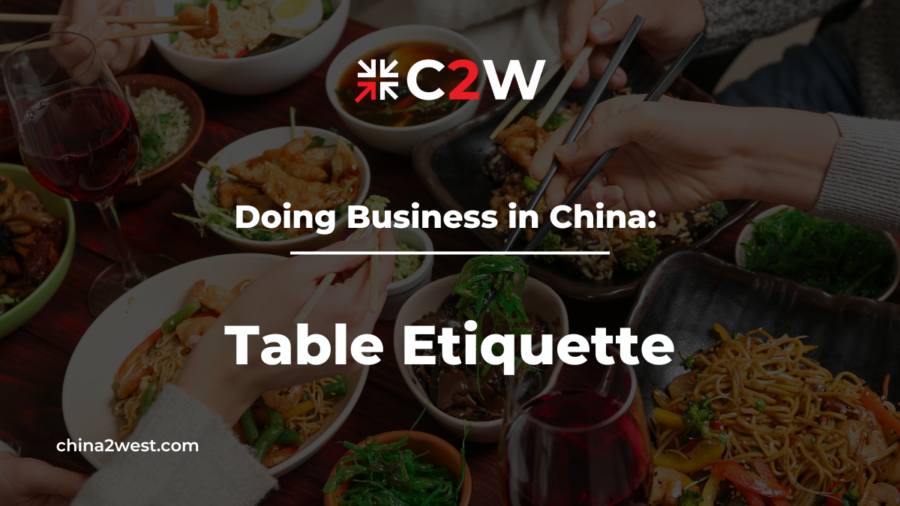Last Updated: February 13, 2023
Dining with your Chinese partner is an expected part when you are doing business in China. Chinese dining etiquette is an important portion of Chinese food culture. Good dining and table manners can show your self-cultivation and leave a good impression on your Chinese host.
For those unfamiliar with Chinese table etiquette, however, it can come as an unpleasant surprise. As opposed to Western dining customs, where everyone is served their own plate, Chinese diners share from the dishes set on the table.
In this blog, we will list more fundamental table etiquette in China. When in Rome, do as the Romans do! Let’s get started!
Seating Arrangements
Chinese culture traditionally utilizes communal dining, so tables are chosen with that in mind. Small groups typically prefer rectangular or square-shaped tables, while large groups require round ones. When the latter is the case, it’s common for the round table to feature a Lazy Susan turntable for conveniently passing dishes.
The formal seating arrangements at a dinner party must adhere to certain guidelines. In Chinese seating arrangements, the guest with the highest status is allocated the seat of honor, located in the center, and facing east or the entrance. Other guests will be placed closer to the seat of honor, and those with lower ranks should sit further away. The host typically sits in the least conspicuous seat near the kitchen entrance or service door and can only be seated after the senior guest or the guest of honor.
Eating Etiquette
There is no universal protocol for business dinners in China. It may vary in size and formality, all of which are determined by the host. When visiting China, make sure you try the local specialties and enjoy an interesting food tour.
Hosts in China are typically known to prepare abundant food and liquor. The host will order more than enough to feed their guests and the menu reflects the local culinary specialties of the region. For instance, the seafood diet is famous in Guangdong Province while spicy dishes are most popular in Hunan Province and Sichuan Province. To avert awkwardness, make sure to inform the host of any dish taboos or dietary restrictions prior to starting the meal.
When it comes to drinks for Chinese business dinners, báijiǔ (白酒 – rice wine) is a perfect fit. This strong, distinctive national beverage of China is widely renowned as the most popular liquor in the world.
The Use of Chopsticks
A utensil of Chinese origins but used all over Asia, the humble chopstick is a versatile tool and sometimes the only tool needed to enjoy a meal.
As Chinese cuisine and culture have become increasingly popular around the world, more and more non-natives are learning to use chopsticks properly, a skill typically picked up during childhood by Chinese individuals. Below, we’ve outlined some key do’s and don’ts to keep in mind when using chopsticks at a business dinner in China.
Dos
- Do hold your chopsticks properly.
- Do use a chopstick rest when you need to take a sip of your beverage or speak to the host. If there isn’t one, you can also lay them down horizontally on your plate.
- Do use serving chopsticks. It is considered impolite to use your chopsticks to pick up the food from the shared plate while serving chopsticks are supplied.
Don’t
- Don’t point at someone with chopsticks or play with chopsticks.
- Don’t wave your chopsticks around as if they were an extension of your hand gestures, bang them like drumsticks, or use them to move bowls or plates.
- Don’t stab food with personal chopsticks again and again.
- Don’t use chopsticks to poke through the food as if you were using a fork.
- Don’t stab chopsticks into a bowl of rice, leaving them standing upwards. Any stick-like object facing upward resembles the incense sticks that some Asians use as offerings to their deceased family members. This is considered the ultimate faux pas on the dining table.
About Us
Finding a proper contract manufacturing company to ensure your product quality can help you avoid lots of trouble. If you are considering outsourcing your project to China, look no further than China 2 West. We have developed to be a famous one-stop-shop manufacturing consultancy from product sourcing and manufacturing to QC inspection and distribution in the Greater Bay Area in Southern China. If you want to know more about how we can help your project, don’t hesitate to contact us today.

